Gjøvik
Gjøvik kommune | |
|---|---|
 Central Gjøvik | |
 Coat of arms 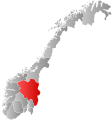 Innlandet within Norway | |
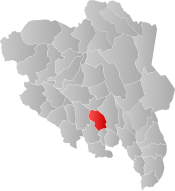 Gjøvik within Innlandet | |
| Coordinates: 60°47′33″N 10°41′42″E / 60.79250°N 10.69500°ECoordinates: 60°47′33″N 10°41′42″E / 60.79250°N 10.69500°E | |
| Country | Norway |
| County | Innlandet |
| District | Vest-Oppland |
| Administrative centre | Gjøvik |
| Government | |
| • Mayor (2014) | Bjørn Iddberg |
| Area | |
| • Total | 672 km2 (259 sq mi) |
| • Land | 630 km2 (240 sq mi) |
| Area rank | 165 in Norway |
| Population (2014) | |
| • Total | 30,063 |
| • Rank | 28 in Norway |
| • Density | 44/km2 (110/sq mi) |
| • Change (10 years) | 2.8% |
| Demonym(s) | Gjøvikenser Gjøvikensar[1] |
| Time zone | UTC+01:00 (CET) |
| • Summer (DST) | UTC+02:00 (CEST) |
| ISO 3166 code | NO-3407 |
| Official language form | Bokmål[2] |
| Website | www |
![]() Gjøvik (help·info) is a town and a municipality in Innlandet (formerly Oppland) [3] county, Norway. The administrative centre of the municipality is the town of Gjøvik.
Gjøvik (help·info) is a town and a municipality in Innlandet (formerly Oppland) [3] county, Norway. The administrative centre of the municipality is the town of Gjøvik.
In 1861, the village of Gjøvik in the municipality of Vardal was granted town status and was separated from Vardal to form a separate municipality. On 1 January 1964, the neighboring rural municipalities of Biri, Snertingdal, and Vardal were all merged into the municipality of Gjøvik.
Etymology[]
The town is named after the old Gjøvik farm (Old Norse: Djúpvík), consisting of the elements djúpr "deep" and vík "inlet".[4]
Coat of arms[]
The coat of arms were granted on 2 September 1960. The arms show a white swan (Cygnus cygnus).
The former coat of arms, adopted in 1922, was a linden tree, with the statement Vis et voluntas (meaning "Force and will") on the lower part of the shield. The following design was a so-called "potpourri" vase, the most significant design of the glassworks that was the funding industry of the town.[5]
Demographics[]
| Ancestry | Number |
|---|---|
| 439 | |
| 283 | |
| 243 | |
| 197 | |
| 194 | |
| 178 | |
| 171 | |
| 156 | |
| 143 | |
| 125 | |
| 114 | |
| 106 |
Geography[]
Along with Hamar, Lillehammer, Brumunddal and Moelv, Gjøvik is one of the many towns bordering Norway's biggest lake, Mjøsa. The town administration of Gjøvik also covers the suburb area Hunndalen and the rural districts of Biri, Snertingdal, and Vardal. The municipal population is 28,807 (2010). About 16,000 people live in the urban area proper.
Gjøvik is bordered on the north by Lillehammer municipality, in the south by Østre Toten and Vestre Toten, and in the west by Søndre Land and Nordre Land. Across Lake Mjøsa to the east lies Ringsaker municipality in Hedmark.
The highest point is Ringsrudåsen with a height of 842 metres (2,762 ft).
Economy[]
Gjøvik owes much of its early growth to the local glassworks, which were established there by Caspar Kauffeldt in 1807. In the early 19th century, there was considerable immigration there from Valdres and Western Norway, aiding Gjøvik's growth. It was granted a town charter in 1861. Later, O. Mustad & Son became one of the world's largest manufacturers of fish hooks.[7][page needed]
Today , and are some of the industrial companies operating from Gjøvik. The town is also a port for the former traffic ship, Skibladner, which is now a tourist ship.
The local paper is the Oppland Arbeiderblad. It was formerly a Labour Party newspaper. Defunct newspapers include Oplændingen and Velgeren (Labour Democrat/Liberal), Samhold (Liberal, later Agrarian) and Ny Dag (Communist).
Gjøvik has two notable hotels, the Grand hotel and the Strand hotel.
There have been three notable concerts held in Gjøvik's history, which starred Toto, Robbie Williams and Bryan Adams (June 2011).

Gjøvik Church[]
Gjøvik Church (Gjøvik kirke) was designed by architect Jacob Wilhelm Nordan. The wooden structure was built between 1881-82. Both the church buildings and fixtures are designed in Gothic Revival architecture. The exterior of the church has contrasting colors on wall surfaces and bearing structures. The altarpiece was painted by artist, Asta Nørregaard. The churchyard has a monument dedicated to the memory of Lutheran missionary, Paul Olaf Bodding. The church was restored during 1927, 1960, 2004-2005 and in 2009.[8][9]
Attractions[]
- The world’s largest arena excavated in rock, called Gjøvik Olympic Hall (Norwegian: Fjellhallen), is located in Gjøvik. It was one of the sites of the Lillehammer Winter Olympics ice hockey games in 1994.
- Gjøvik farm
- Gjøvik glassworks
- Eiktunet cultural-history museum
- The world's oldest paddle steamer still on a regular schedule, the PS Skibladner
- Biri Travbane
Notable people from Gjøvik[]


Public Service & public thinking[]
- Anders Lysgaard (1756–1827) farmer and rep. at the Norwegian Constituent Assembly
- Hans Schikkelstad (1789–1843) farmer and politician; founded O. Mustad & Søn
- Balthazar Mathias Keilhau (1797–1858) a Norwegian geologist and mountain pioneer
- Hans Mustad (1837–1918) Norwegian businessperson, shaped the company O. Mustad & Son
- Johan Castberg (1862–1926) jurist and politician in Gjøvik 1890-1900
- Paul Olaf Bodding (1865–1938), missionary to India, monument at Gjøvik church
- Ole Evinrude (1877–1934) a Norwegian-American, invented the first practical outboard motor
- Niels Ødegaard (1892–1976) an educator, newspaper editor and politician
- Harold Harby (1894–1978), City Council member, Los Angeles, California
- Arne Austeen DFC (1911–1945) a Norwegian flying ace, killed in WWII
- Ragnhild A. Lothe (born 1958) a microbiologist and cancer researcher
- Hans Olav Lahlum (born 1973) an historian, crime author, chess player and politician
The Arts[]
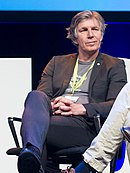
- Finn Lange (1895–1976) a Norwegian actor [10]
- Georg Adelly (1919–1997) a Swedish film actor [11]
- Torbjørn Sunde (born 1954) a jazz trombonist and former speed-skater
- Kjell Ola Dahl (born 1958), author of Nordic noir crime novels
- Per A. Borglund (born 1961) a Norwegian newspaper and magazine editor
- Per Elvestuen (born 1962) a Norwegian illustrator.
- Mai Britt Normann (born 1966) a Norwegian singer-songwriter
- Eirik Hegdal (bornr 1973) a jazz saxophonist, composer & leader of Trondheim Jazz Orchestra
- Ali Pirzad-Amoli (born 1988) stage name A-Lee pop singer-songwriter and rapper
- Anna Lotterud (born 1989) stage name Anna of the North, singer-songwriter
- Nora Foss al-Jabri (born 1996) singer, participant in the Norwegian 2012 Eurovision Song Contest
Sport[]
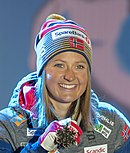
- Guttorm Berge (1929–2004) an Alpine skier, bronze medalist at the 1952 Winter Olympics
- Roger Aandalen (born 1965) a Norwegian boccia player, paralympic medallist
- Bente Nordby (born 1974) a former football goalkeeper, 172 caps with Norway women
- Else-Marthe Sørlie Lybekk (born 1978) a retired team handball player, Olympic medallist
- Gro Hammerseng (born 1980), handball player, captain of the Norwegian national team
- Ingvild Flugstad Østberg (born 1990) cross-country skier, silver and team gold medallist at the 2014 Winter Olympics
- Maren Lundby (born 1994) successful ski jumper, gold medallist at the 2018 Winter Olympics
Twin towns – sister cities[]
Gjøvik is twinned with:[12]
Gallery[]

Gjøvik City Hall
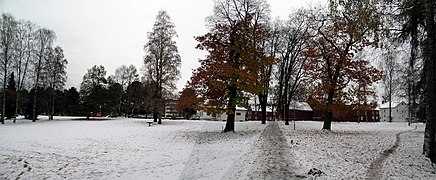
Park at the Gjøvik farm

Skibladner boathouse, Gjøvik
References[]
- ^ "Navn på steder og personer: Innbyggjarnamn" (in Norwegian). Språkrådet.
- ^ "Forskrift om målvedtak i kommunar og fylkeskommunar" (in Norwegian). Lovdata.no.
- ^ moderniseringsdepartementet, Kommunal- og (7 July 2017). "Regionreform". Regjeringen.no. Archived from the original on 23 March 2018. Retrieved 28 April 2018.
- ^ Rygh, Oluf (1900). Norske gaardnavne: Kristians amt (Anden halvdel) (in Norwegian) (4 ed.). Kristiania, Norge: W. C. Fabritius & sønners bogtrikkeri. p. 40.
- ^ Norske Kommunevåpen (1990). "Nye kommunevåbener i Norden". Retrieved 2009-01-01.
- ^ "Immigrants and Norwegian-born to immigrant parents, by immigration category, country background and percentages of the population". ssb.no. Archived from the original on 2 July 2015. Retrieved 26 June 2017.
- ^ Stagg, Frank Noel (1956). East Norway and its Frontier. George Allen & Unwin, Ltd.
- ^ Anne Wichstrøm. "Asta Nørregaard". Norsk biografisk leksikon. Retrieved February 1, 2018.
- ^ Torstein Jørgensen. "Paul Olaf Bodding". Norsk biografisk leksikon. Retrieved February 1, 2018.
- ^ IMDb Database retrieved 15 January 2021
- ^ IMDb Database retrieved 15 January 2021
- ^ "Vennskapsbyer". gjovik.kommune.no (in Norwegian). Gjøvik Kommune. Retrieved 2021-01-31.
External links[]
| Wikimedia Commons has media related to Gjøvik. |
| Look up Gjøvik in Wiktionary, the free dictionary. |
 Gjøvik travel guide from Wikivoyage
Gjøvik travel guide from Wikivoyage- Municipal fact sheet from Statistics Norway
- Tourist information
- NTNU Gjøvik - University
- Gstud - Student society in Gjøvik
- GSR: Gjøvik Student Radio – Online radio voluntarily run by Gstud
- Gjøvik
- Cities and towns in Norway
- Municipalities of Oppland






